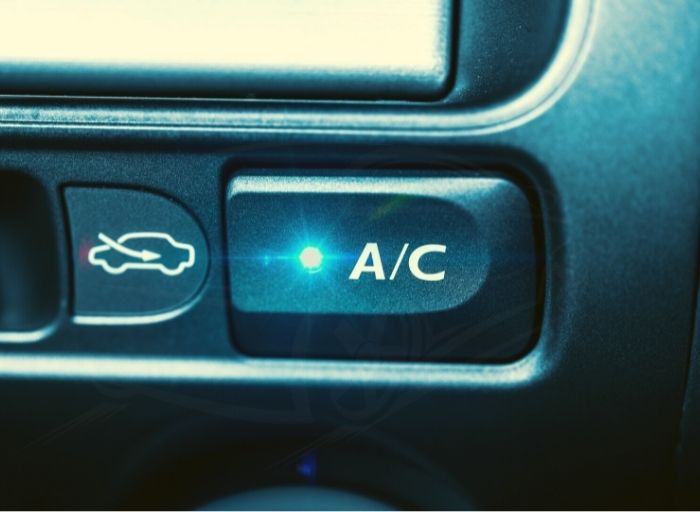
Today, air conditioning (A/C) is standard on most vehicles. It’s worth mentioning, though, that the system is only effective when everything works as it should. A vehicle’s air conditioning, like any mechanical system, is prone to failure. So, how to fix car AC not blowing cold air?
Table of Contents
Understanding the Car’s AC System
Because of the location of the hoses and lines, your vehicle’s air conditioning system can be complicated. First, the refrigerant is compressed and heated in your vehicle’s air conditioning system, then allowed to decompress and condense into a liquid, causing it to lose heat rapidly. This procedure absorbs heat from the cabin and is repeated until the required temperature is reached.
The basic concept becomes much easier to grasp when the parts are broken down. An engine belt drives the compressor, which compresses the gaseous refrigerant.
The condenser cools it down through a series of finned tubes once it has been compressed, allowing it to return to a liquid condition. This liquid will next flow through a dryer or receiver, which will remove any excess water, reducing the likelihood of ice crystal development within the AC system.
The liquid refrigerant then passes through a thermal expansion valve into the evaporator, which is affected by the temperature of the vehicle’s cabin. The fluid boils at this point, reducing it to a gas state once more. The heat from the surrounding air is absorbed during this process, causing the evaporator coil to cool. Finally, it is circulated throughout the cabin as cool, crisp air-conditioned air by the blowing fan through the vents.
A compressor, condenser, and evaporator are found in almost every car, and they all help us keep cool during the hot summer months. Unfortunately, when any of these components fail, you’re left with unbearable heat that even a rolled-down window can’t alleviate.
How to Fix Car Ac Not Blowing Cold Air: Causes & Solutions
The following are some common reasons why your car’s air conditioner isn’t blowing cold air:
Leaks of Refrigerant
The most typical problems connected with a poorly performing AC system are low refrigerant levels caused by a leaky O-ring, seal, or other components. The cold level of the air exiting the vents can be affected by even a small loss of refrigerant. Short-cycling or the AC compressor frequently turning off and on is a solid symptom of low refrigerant.
Even the specialists have trouble finding refrigerant leaks. Examine the condenser (placed in front of the radiator), compressor, and refrigerant hoses or fittings for oil stains. Check that the valve caps and O-rings on the AC service port (Schrader) are simply hand-tightened.
A variety of DIY AC system recharge kits are available. Oil, color to aid spot leaks, and additives to renew O-rings and seals are a few examples. Get a kit with a gauge to evaluate system pressure before adding refrigerant that fits the type of refrigerant in your vehicle. The AC system is normally recharged only once.
Cabin Filter Blocked
When troubleshooting an AC system problem, this one is frequently neglected. A dirty cabin air filter can cause poor AC cooling performance and is simple to change.
Air Conditioner Compressor
Another major source of auto air conditioning issues is the compressor. First, make sure the clutch assembly is engaged at the front of the AC compressor.
The clutch should be spinning when the engine is running, the blower fan is set to maximum high, and the AC controls are set to the lowest temperature. When the clutch engages, you may hear a little “click” or notice a change in engine speed. If the clutch does not employ, the refrigerant level in the AC system is either deficient, there is an electrical fault, or the clutch has failed. The compressor might also be damaged by corrosion or worn interior parts.
Air Conditioner Evaporator
If the blower fan is working but no air flows out of the vents, the evaporator fins are most likely clogged with leaves or debris. An unusual odor usually indicates that the evaporator is leaking refrigerant when using the air conditioner. Since the evaporator is normally hidden beneath the instrument panel, the mechanic will have to determine if it is the source of the problem.
Air Conditioner Condenser
When the air conditioner is turned on, ensure the radiator cooling fans are functioning. Paper, leaves, dust, debris, and bent cooling fins will boost the temperature of the refrigerant, resulting in inadequate cooling and the possibility of engine overheating. In addition, excessive AC pressure causes rattling or banging in the compressor and drive belt slippage. Flush the condenser and radiator fins with your garden hose.
What Will be the Repair Cost?
The cost of repairing an air conditioning system varies substantially depending on the nature and depth of the problem. Furthermore, the retail price of various components inside a vehicle’s A/C system might vary dramatically between makes and models.
Having your air conditioning system recharged with refrigerant will cost you between $100 and $250. This implies no major system leaks and that refrigerant levels have declined over time due to gradual loss.
On the other hand, in an internal A/C compressor failure, one should anticipate paying substantially more. When this happens, the system must be cleaned before a new compressor can be installed.
The metering device and receiver/dryer in the system should be replaced as well. This type of work typically costs between $500 to $1100, including labor.
Prevention and Treatment
Running the air conditioner for 10 minutes a week in the winter helps circulate refrigerant oil, lubricate the compressor, and condition O-rings and seals. If the DIY solutions provided here don’t work or the system won’t switch on, take the vehicle to a certified mechanic. They have the specialized tools and equipment needed to precisely diagnose the problem, safely recover and recycle refrigerant, and repair the system to keep you cool while driving.
Hi there! I’m Naomi O’Colman. I’ve got years of experience working at an auto repair shop here in Texas under my belt. On top of that, ever since I was a kid I’ve been passionate about the auto industry. Since I’ve joined the team at automotivegearz.com I’ve been enthusiastically sharing my passion and insights with my readers. I’m dedicated to delivering high quality content and helping you stay up to date with the latest automotive trends and products out there!







